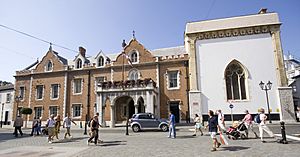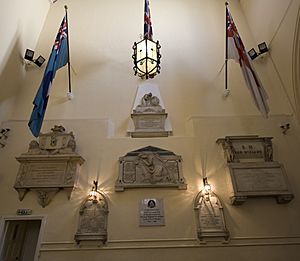King's Chapel, Gibraltar facts for kids
Quick facts for kids King's Chapel |
|
|---|---|

Interior of the King's Chapel, Gibraltar
|
|
| 36°08′14″N 5°21′12″W / 36.13727°N 5.353319°W | |
| Location | Main Street |
| Country | |
| Denomination | Church of England (1728-present) Catholic Church (1530s-1728) |
| History | |
| Status | Chapel |
| Founded | 1530s |
| Architecture | |
| Functional status | Active |
| Architect(s) | Various |
| Architectural type | Mixed |
| Style | Mixed |
King's Chapel is a small chapel in Gibraltar, a British territory. It is found at the end of Main Street. The chapel is right next to The Convent, which is where the Governor of Gibraltar lives. This chapel was the very first church built specifically as a church in Gibraltar.
It started as part of a Franciscan friary in the 1530s. After the British took Gibraltar in 1704, the chapel was given to the Church of England. King's Chapel was damaged twice, once during the Great Siege of Gibraltar in the late 1700s and again in 1951 by a ship explosion. Both times, it was repaired and brought back to life. From 1844 to 1990, it was the main church for the British Army in Gibraltar. Now, all three parts of the British Armed Forces use it.
Contents
A Look Back: The Chapel's Journey

After Castile took Gibraltar from the Moors in 1462, Franciscan friars came to the city. They built a friary and a church. While two other churches existed, they were originally mosques that had been changed into Christian churches. The Franciscan church was the first completely new church built in Gibraltar.
In 1704, British and Dutch forces captured Gibraltar during a war. The new British Governor took over the friary, which became known as The Convent. It is still used as the Governor's home today. The Franciscan church was then given to the Church of England and renamed "The King's Chapel." It was the only church that stayed open for services in Gibraltar after the capture.
Challenges and Changes
The chapel faced tough times during the Great Siege of Gibraltar (1779–1783). Like many buildings, it was used to shelter soldiers and supplies. Spanish attacks caused a lot of damage, and the chapel's western end and south side were destroyed. These parts were rebuilt after the siege, but they were changed. The western end became the Governor's ballroom, and the south side became the main staircase.
Today, the chapel is only the eastern half of the original church. Before the attacks, the chapel also lost its belfry. It was taken down in 1779 so Spanish gunners couldn't use it as a target. The chapel's bell was not returned until 1995.
The chapel reopened in 1788. The Governor and his staff attended services there. However, it was too small for all the soldiers. By the 1820s, it was also too small for the growing number of civilian Anglican worshippers.
A New Purpose
In 1832, the larger Cathedral of the Holy Trinity was finished. King's Chapel then became the Governor's private chapel for a short time. In 1833, an order came to close King's Chapel, which many people in Gibraltar protested.
The chapel got a new life in 1844 when the Royal Engineers repaired it. It became an extra place of worship for Gibraltar's civilians. The Cathedral of the Holy Trinity had become too full with military personnel.
The chapel's name changed to Queen's Chapel during Queen Victoria's reign. But it went back to King's Chapel after her death and stayed that way when Elizabeth II became queen in 1952.
In 1877, the chapel was restored again, and new stained glass windows were added. An organ was installed in 1887. The chapel survived both World Wars without damage. However, it was badly hit on April 27, 1951. This happened when the RFA Bedenham, an ammunition ship, exploded in Gibraltar's harbour. The explosion destroyed the chapel's ceiling and all its stained glass.
Restoring the Chapel's Beauty
After the 1951 explosion, the chapel was restored. New stained glass windows were put in place in 1952. One window shows King George VI. Another, in the east wall, shows Christ surrounded by angels. Below this, the crucifixion is shown, with the Virgin Mary and Saint Bernard, Gibraltar's patron saint, on either side.
Other parts of the window show British Armed Forces members, Franciscans, and the capture of Gibraltar in 1704. You can also see Saint George, the Royal Arms, and the British Army's crest. Inside the chapel, there are many memorials to members of the British Armed Forces. There are also tombs and memorials for several governors and their wives.
Today, the chapel is used by all three British Armed Forces: the Army, Royal Navy, and Royal Air Force. Before 1990, each service used a different church. Now, a Royal Navy chaplain at King's Chapel provides support for all three. Roman Catholics also hold regular services there. The chapel is open to the public every day.
Important Memorials
- John Hennen, a military surgeon and writer.


